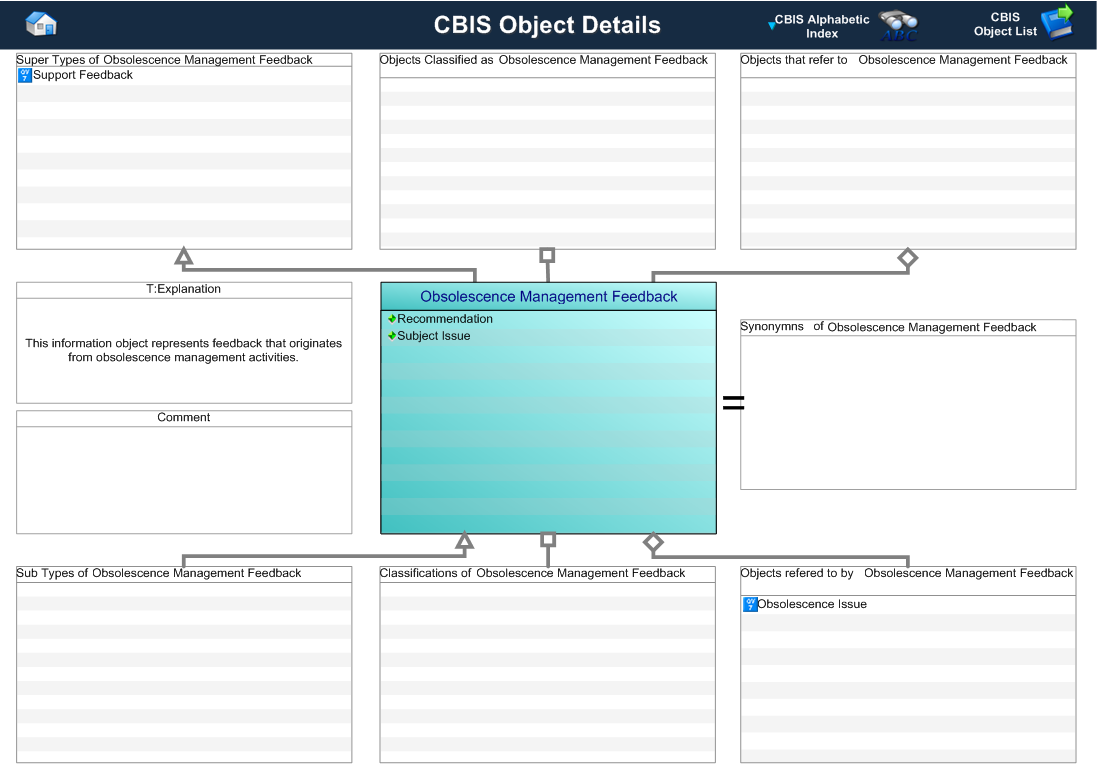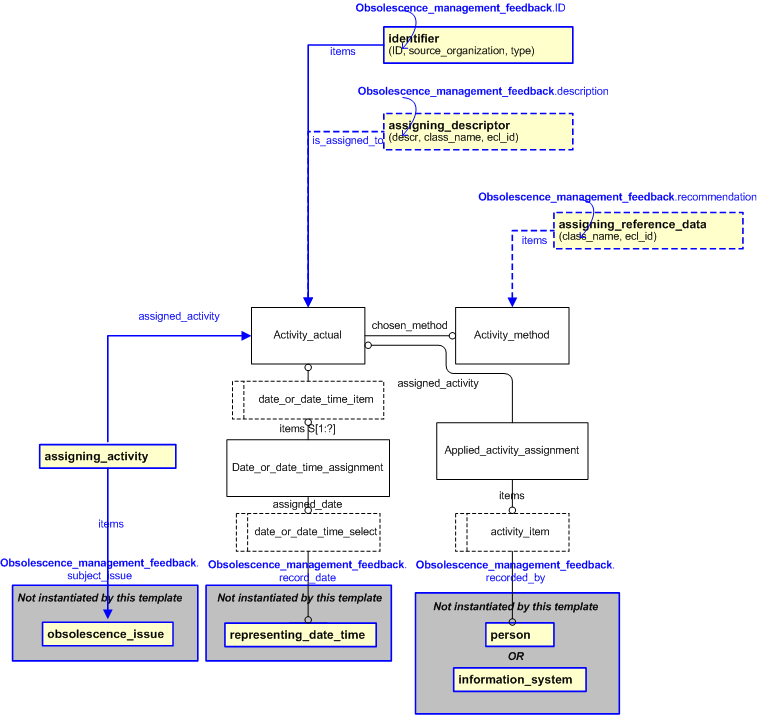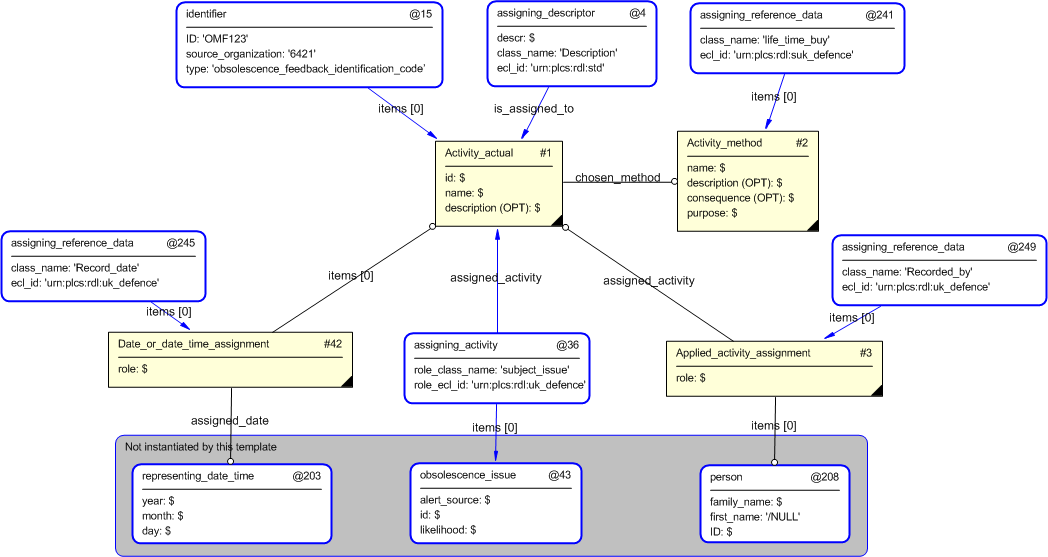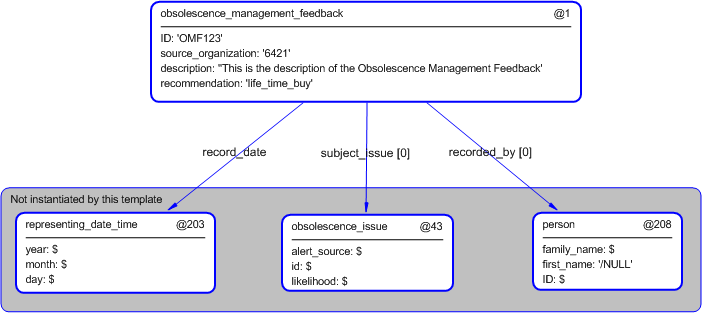Template:— obsolescence_management_feedback (obslscnce_mgt_fdbk)
Context:— UK_Defence |
Date: 2010/03/15 14:46:04
Revision: 1.5
|
This section specifies the template obsolescence_management_feedback.
NOTE
The template has been defined in the context of
UK_Defence.
Refer to the business context for details of related templates.
NOTE
An explanation of a template and the associated instantiation path is
provided in the
Template overview
section.
This template describes how to represent the concept of an obsolescence_management_feedback in terms of PLCS model elements
(templates, entities, and reference data).
A fleet is a named collection of products that are managed as a whole to meet an operational requirement.
The EXPRESS-G diagram in
Figure
2
shows the templates and EXPRESS entities that are required
to represent the template
"obsolescence_management_feedback".
The text highlighted in blue shows the template parameters.
Figure 2 — An EXPRESS-G representation of the Information model for obsolescence_management_feedback
The graphic for the template to be used in other EXPRESS-G diagrams
is shown in Figure
3
below.
Figure 3 — The graphical representation of the obsolescence_management_feedback template
The following input parameters are defined for this template:
This is the identifier of the feedback.
The organization that created the identifier. Additionally
a Person or Information System could be defined when either of these are the source; see Identifier template.
This is a description of the feedback.
This is the date and time on which the support feedback record was made.
This is the reference to the person or system which recorded the feedback.
This is a recommendation of what should be done to address to the obsolescence problem.
This is a reference to the obsolescence issues that are subject to the feedback report.
The following reference parameters are defined for this template:
Allow the
Activity_actual
entity instantiated in this path to be referenced when this template is used.
%^target = $obsolescence_management_feedback.obs_mgt_fbk%
The instantiation path shown below specifies the entities that are to be
instantiated by the template.
A description of templates and the syntax for the instantiation path is
provided in the
Templates Help/Information section.
Activity_methodActivity_method.name = '/IGNORE'
Activity_method.description = '/IGNORE'
Activity_method.consequence = '/IGNORE'
Activity_method.purpose = '/IGNORE'
Activity_actualActivity_actual.chosen_method ->
Activity_method%^obs_mgt_fbk =
Activity_actual%
-- ID /
identifier(
ID=@ID,
source_organization=@source_organization,
type='obsolescence_management_feedback_id_code',
items=^obs_mgt_fbk)/
-- [Optional Description] /
assigning_descriptor(
descr=@description,
class_name='Description',
ecl_id='urn:plcs:rdl:uk_defence',
is_assigned_to=^obs_mgt_fbk)/
-- recommendation /
assigning_reference_data(
items=Activity_method,
class_name=@recommendation,
ecl_id='urn:plcs:rdl:uk_defence')/
-- relationship to record_date Date_or_date_time_assignmentDate_or_date_time_assignment.role = '/IGNORE'
Date_or_date_time_assignment.items ->
^obs_mgt_fbk
Date_or_date_time_assignment.assigned_date ->
@record_date%^record_date_time =
Date_or_date_time_assignment%
/
assigning_reference_data(
items=^record_date_time,
class_name='Record_date',
ecl_id='urn:plcs:rdl:uk_defence')/
-- relationship to recorded by Applied_activity_assignmentApplied_activity_assignment.role = '/IGNORE'
Applied_activity_assignment.items ->
@recorded_byApplied_activity_assignment.assigned_activity ->
^obs_mgt_fbk
%^rec_by =
Applied_activity_assignment%
/
assigning_reference_data(
items=^rec_by,
class_name='Recorded_by',
ecl_id='urn:plcs:rdl:uk_defence')/
-- relationship to subject issue /
assigning_activity(
role_class_name='subject_issue',
role_ecl_id='urn:plcs:rdl:uk_defence',
assigned_activity=^obs_mgt_fbk,
items=@subject_issue)/
The following entities are instantiated with attributes as specified:
The instance diagram in Figure
4
shows an example of the EXPRESS entities and templates that are instantiated by the template:
/obsolescence_management_feedback(description='This is the description of the Obsolescence Management Feedback', ID='OMF123', source_organization='6421', record_date='@203', recorded_by='@208', recommendation='life_time_buy', subject_issue='@43')/
(an illustration of the consolidated obsolescence_management_feedback template is shown in
Figure
5 below.)
Figure 4 — Entities instantiated by obsolescence_management_feedback template
The instance diagram in
Figure
5
shows the graphic symbol for the template that is to be
used in other instance diagrams. The example template is:
/obsolescence_management_feedback(description='This is the description of the Obsolescence Management Feedback', ID='OMF123', source_organization='6421', record_date='@203', recorded_by='@208', recommendation='life_time_buy', subject_issue='@43')/
Figure 5 — Instantiation of obsolescence_management_feedback template
Characterizations
No common characterizations of the template
obsolescence_management_feedback
have been identified. However, the ISO 10303-239 EXPRESS model
may enable other assignments to the entities instantiated by the template.




